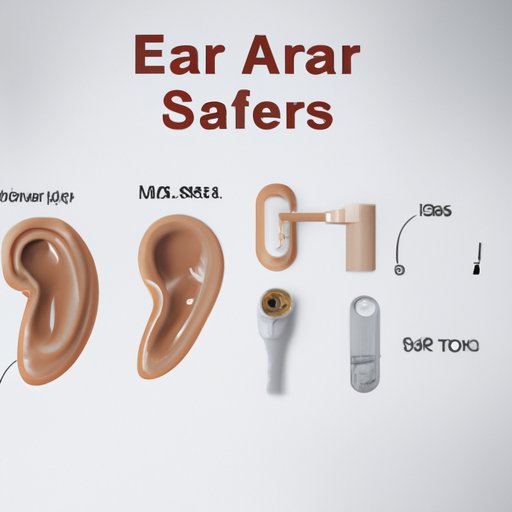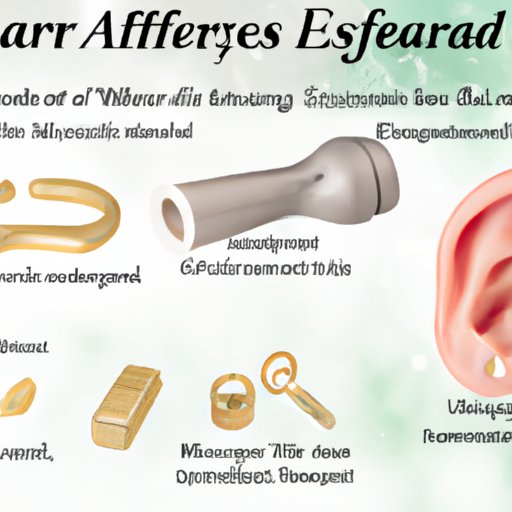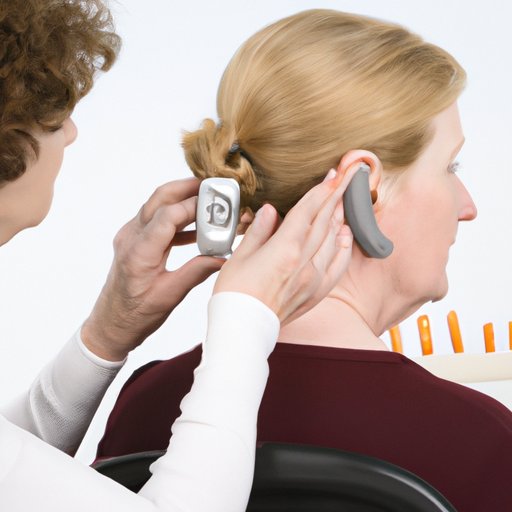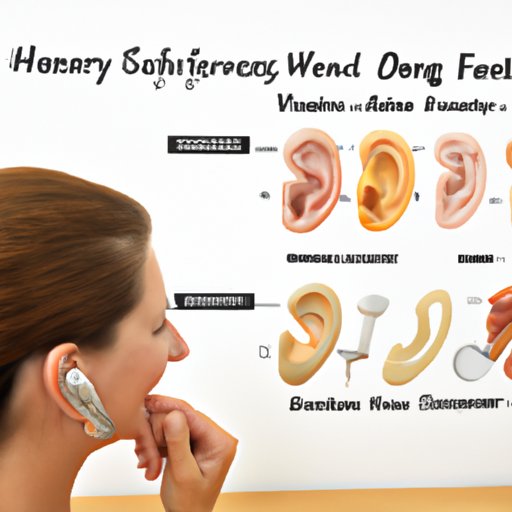Introduction
Hearing loss is a common problem that affects millions of people all over the world. According to the World Health Organization, over 5% of the world’s population – or 466 million people – have disabling hearing loss. For those affected by hearing loss, the use of a hearing aid can be a life-changing solution.
Hearing aids are small electronic devices that amplify sound and help people with hearing loss to hear more clearly. They are designed to fit comfortably behind or inside the ear, and can be customized to suit the individual user’s hearing needs. In this article, we will explore how a hearing aid works, including the different types, technology, components, settings, features, and maintenance.

Different Types of Hearing Aids and How They Work
Hearing aids come in a variety of styles and sizes, each with its own unique features and benefits. The most common types are:
Behind-the-Ear (BTE) Hearing Aids
Behind-the-ear (BTE) hearing aids are the most popular type of hearing aid. They consist of two parts: an earmold that fits into the ear canal, and a plastic case that sits behind the ear. The sound is amplified by a microphone in the earmold, which sends signals to the case, which then amplifies the sound before sending it back to the ear.
In-the-Ear (ITE) Hearing Aids
In-the-ear (ITE) hearing aids are larger than BTE hearing aids, but they are still relatively discreet. They fit directly inside the ear and are custom-made to fit the user’s ear shape. They contain a microphone, amplifier, and receiver, and the sound is amplified before being sent to the ear.
In-the-Canal (ITC) Hearing Aids
In-the-canal (ITC) hearing aids are smaller than ITE hearing aids and fit partly in the ear canal. They are less visible than other types of hearing aids and are less likely to pick up wind noise. Like ITE hearing aids, ITC hearing aids contain a microphone, amplifier, and receiver.
Completely-in-the-Canal (CIC) Hearing Aids
Completely-in-the-canal (CIC) hearing aids are the smallest type of hearing aid. They fit entirely in the ear canal and are almost invisible when worn. CIC hearing aids contain a microphone, amplifier, and receiver, and the sound is amplified before being sent to the ear.

An Overview of Hearing Aid Technology and Its Benefits
Modern hearing aids use digital signal processing (DSP) technology to convert sound waves into digital signals, which are then converted back into sound waves. This process allows for greater accuracy and clarity of sound, as well as improved noise reduction capabilities.
Many hearing aids also feature directional microphones, which allow users to focus on a specific sound source, such as a conversation partner, while reducing background noise. Additionally, many hearing aids have built-in noise reduction technology, which helps to reduce distracting background noise.
Investigating the Components of a Hearing Aid and How They Operate
Hearing aids have three main components: a microphone, an amplifier, and a receiver. The microphone picks up sound waves from the environment and converts them into electrical signals. The amplifier amplifies the signals and sends them to the receiver, which converts the signals back into sound waves and sends them to the ear.
Microphone
The microphone is responsible for picking up sound waves and converting them into electrical signals. Some hearing aids have multiple microphones for improved sound quality and directionality.
Amplifier
The amplifier takes the electrical signals from the microphone and increases their volume. It also filters out background noise and adjusts the frequency of the sound waves to make them easier to understand.
Receiver
The receiver takes the amplified electrical signals from the amplifier and converts them back into sound waves. It then sends the sound waves to the ear via a tiny speaker.

Examining the Different Settings and Features of a Hearing Aid
Hearing aids have a range of settings and features that allow users to customize their hearing experience. These include:
Volume Control
Most hearing aids have a volume control that allows users to adjust the level of amplification. This can be used to make speech easier to understand in noisy environments.
Frequency Adjustment
Some hearing aids have adjustable frequency settings, allowing users to tailor the sound to their individual hearing needs. This can be useful for people with hearing loss in certain frequencies.
Program Selection
Many hearing aids have multiple programs that can be selected depending on the user’s listening environment. For example, some hearing aids have a “noise reduction” program that reduces background noise, making conversations easier to understand.

Evaluating the Pros and Cons of Wearing a Hearing Aid
Wearing a hearing aid can be beneficial for people with hearing loss, but there are also some drawbacks. Here are some of the pros and cons of wearing a hearing aid:
Pros
Hearing aids can improve communication and social interaction, as well as reduce feelings of isolation. Additionally, they can help to improve concentration, memory, and overall quality of life. According to a study published in the journal Ear and Hearing, “those who wear hearing aids report better quality of life than those who do not.”
Cons
Hearing aids can be expensive and may require periodic maintenance. Additionally, they can be uncomfortable and may cause feedback or whistling sounds. Finally, hearing aids may not be suitable for people with certain medical conditions.
Discussing the Maintenance of Hearing Aids and Their Lifespan
Hearing aids require regular maintenance to ensure they remain in good working order. Here are some tips for keeping your hearing aids in top condition:
Cleaning and Storage
It is important to keep your hearing aids clean and dry. Use a soft cloth to wipe away any dirt or debris, and store them in a cool, dry place when not in use.
Battery Life
Hearing aids use batteries, which should be replaced regularly. Depending on the type of battery, they may need to be replaced every few days or weeks.
Repairs and Replacements
If your hearing aid stops working, it may need to be repaired or replaced. Most hearing aids come with a warranty that covers repairs or replacements if necessary.
Examining the Latest Advances in Hearing Aid Technology
Recent advances in hearing aid technology have made it easier than ever for people with hearing loss to stay connected. Here are some of the latest developments in hearing aid technology:
Wireless Connectivity
Wireless hearing aids are now available that allow users to connect to their smartphones, TVs, and other devices. This allows users to easily stream audio directly to their hearing aids.
Smartphone Compatible Hearing Aids
Smartphone compatible hearing aids are now available that allow users to control their hearing aid settings using their smartphone. This makes it easy to adjust the volume, frequency, and other settings from anywhere.
Rechargeable Hearing Aids
Rechargeable hearing aids are now available that allow users to charge their hearing aids without having to replace the batteries. This makes it more convenient and cost-effective to use hearing aids.
Conclusion
Hearing aids are small electronic devices that can help people with hearing loss to hear more clearly. They come in a variety of styles and sizes, and use digital signal processing technology to convert sound waves into digital signals. Hearing aids have three main components – a microphone, an amplifier, and a receiver – that work together to amplify sound and send it to the ear. They also have a range of settings and features that allow users to customize their hearing experience. While hearing aids can be beneficial for people with hearing loss, they may also have some drawbacks, such as discomfort and expense. It is important to maintain hearing aids regularly to ensure they remain in good working order. Finally, recent advances in hearing aid technology have made it easier than ever for people with hearing loss to stay connected.
Overall, hearing aids can be a life-changing solution for those affected by hearing loss. With the right care and maintenance, they can help to improve communication, social interaction, and overall quality of life.
(Note: Is this article not meeting your expectations? Do you have knowledge or insights to share? Unlock new opportunities and expand your reach by joining our authors team. Click Registration to join us and share your expertise with our readers.)
